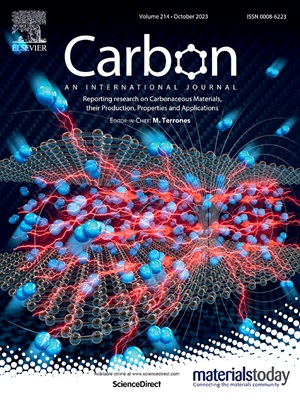A diameter selective fullerene-mediated supramolecular self-assembly motif for single-walled carbon nanotube enrichment
IF 11.6
2区 材料科学
Q1 CHEMISTRY, PHYSICAL
引用次数: 0
Abstract
Post-synthetic diameter-selective separation of nanotubular structures has relied on exohedral interactions; a diameter-dependent enrichment via endohedral interactions for the purification of bulk single-walled carbon nanotubes (SWCNTs) remains unexplored. This paper describes a novel diameter-selective supramolecular self-assembly motif for nanotube enrichment via fullerene (C60) encapsulation by SWCNTs. C60-grafted silicon wafers and silica particles were used for the diameter-selective self-assembly and enrichment/separation of individualized SWCNTs, respectively. C60 grafting to silica substrates was performed via the addition of azide-terminated silane precursors, followed by the cycloaddition of azides with C60 to azafulleroids. Atomic force microscopy was used to determine the diameter dependency of the method. The diameter-sorted SWCNTs were further characterized via ultraviolet–visible–near-infrared spectroscopy and Raman spectroscopy. The method presented here was found to select SWCNTs with diameters of approximately 1.4–1.7 nm, with a central cavity matched to the diameter of C60. Self-assembly and enrichment/separation of other nanotubular structures are anticipated with this approach.

一个直径选择性富勒烯介导的超分子自组装基序用于单壁碳纳米管富集
纳米管结构的合成后直径选择分离依赖于外面体相互作用;是否通过内源性相互作用进行直径依赖性富集以纯化块状单壁碳纳米管(SWCNTs)仍有待进一步研究。本文描述了一种新的直径选择性超分子自组装基序,用于通过SWCNTs包封富勒烯(C60)富集纳米管。c60接枝硅片和二氧化硅颗粒分别用于个性化SWCNTs的直径选择性自组装和富集/分离。通过添加叠氮端硅烷前驱体,将C60接枝到二氧化硅基体上,然后将叠氮与C60环加成到氮杂化物。采用原子力显微镜测定方法的直径依赖性。通过紫外-可见-近红外光谱和拉曼光谱进一步表征了直径分级的SWCNTs。该方法选择的SWCNTs直径约为1.4-1.7 nm,中心空腔与C60的直径相匹配。该方法有望实现其他纳米管结构的自组装和富集/分离。
本文章由计算机程序翻译,如有差异,请以英文原文为准。
求助全文
约1分钟内获得全文
求助全文
来源期刊

Carbon
工程技术-材料科学:综合
CiteScore
20.80
自引率
7.30%
发文量
0
审稿时长
23 days
期刊介绍:
The journal Carbon is an international multidisciplinary forum for communicating scientific advances in the field of carbon materials. It reports new findings related to the formation, structure, properties, behaviors, and technological applications of carbons. Carbons are a broad class of ordered or disordered solid phases composed primarily of elemental carbon, including but not limited to carbon black, carbon fibers and filaments, carbon nanotubes, diamond and diamond-like carbon, fullerenes, glassy carbon, graphite, graphene, graphene-oxide, porous carbons, pyrolytic carbon, and other sp2 and non-sp2 hybridized carbon systems. Carbon is the companion title to the open access journal Carbon Trends. Relevant application areas for carbon materials include biology and medicine, catalysis, electronic, optoelectronic, spintronic, high-frequency, and photonic devices, energy storage and conversion systems, environmental applications and water treatment, smart materials and systems, and structural and thermal applications.
 求助内容:
求助内容: 应助结果提醒方式:
应助结果提醒方式:


